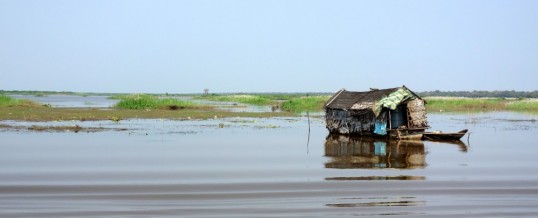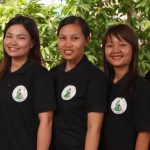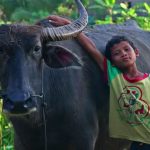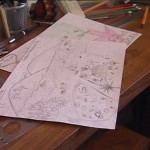
Flat on my back, I lay there, in the darkness, looking up on what reminded me of a bridal veil just about a meter above my head. It was slightly lit up by the bright light bulb on the outside. Bugs were dancing in the beam of light. Dogs were barking in the distance. A noisy motor boat was passing by, and seconds later the small, rapid waves hit the platform. I could hear the wings of insects that were swirling around. My nose was filled by the smell of my own sweat and mosquito repellent.
My first meeting with an alternative kind of clinic
Occasionally, someone coughed. At some point during the night, somewhere in the village, Gangnam Style was played loudly. Around 5 in the morning, after a night of no sleep, I would open heavy eyelids. It was still dark. Something had hit the platform. A boat, I assumed. Then I heard voices. I made a small jump as I sat up in bed, and managed to wake up the person next to me. I couldn’t quite remember, but I believed that her name was Sopeak. “There is someone outside,” I whispered with a shaky voice. “Patients,” the doctor replied and went back to sleep for another hour.
This was my first meeting with an alternative kind of clinic, three years ago. I dare to argue that the word ‘clinic’ tends to draw a certain image in our minds. A firm handshake as you enter the room. A doctor in a white scrub. A clean, bright office. Anatomy posters decorating the walls. Fingers moving quickly over the computer keyboard as you explain to the doctor what’s wrong. Some strange equipment you don’t know the name of along with stethoscopes, antibacterial hand sanitizers and family photos decorating the desk. Now, imagine a clinic in an underdeveloped country. What do you see?
South-East Asia’s largest lake and home to 1.2 million people
Cambodia is one of the poorest countries in the world. Despite the fact that the larger cities have experienced economic growth in the past decade due to an increase in tourism, the case is not the same for the Tonlé Sap region. Tonlé Sap is South-East Asia’s largest lake, and also home to 1.2 million people who live in floating houses or houses built on piles. The word ‘house’ is an exaggeration. These constructions are pieces of sticks and palm leaves tied together. Making it even more difficult is the extreme climate. The dry season is characterized by severe drought and water level in some places being as low as 30 centimeters. The monsoon season, on the other hand, is defined by strong winds and heavy rain which threaten the fragile homes of the villagers, and furthermore contributes to an increase in the water level, which in some areas can be as deep as 10 meters. The nearest health facilities are hours away, and education is almost non-existent. The knowledge gap about sanitation and hygiene is large, which makes the people suffer from illnesses that could be easily prevented.
Srey Pheap’s story
Picture yourself being a woman in one of these floating houses. You have been pregnant eight times. Five of the eight children still live. Your husband is a fisherman, so the only boat that the family owns is being used for fishing big parts of the day. A couple of your children are out there in the hot midday sun with their father, ensuring that you have dinner tonight, and – if they manage to catch more fish than you would consume – some income for tomorrow. You have lived in this very village being surrounded by water your whole life, but you have never learned to swim. Almost none of the villagers know how to swim. When you were ten years old, you witnessed the impact of this. Your younger sister had used a small washing basin as a ‘boat’ to paddle her way to a house on the other side of the open area dividing the village, or, the ‘water road’, if you like.
One hand at a time, she slowly paddled her way further and further away from your house. About midway, a small motor boat went quickly through the village, passing right beside your sister. She could have been hit by the boat. What happened instead was much worse. The basin was hit by the waves and started shaking. You heard a scream as she fell into the water. Your parents and the most immediate neighbours were not present. They were out fishing. You felt paralyzed as you watched her use her last strength to splash around in the water and scream whenever her mouth reached the surface. She screamed and coughed interchangeably, as the dirty lake water went into her mouth. Then silence. A neighbour had gotten into a small boat and was on his way out to your sister. But it was too late. And now, you are an adult, every day hoping that your own children will not fall into the water without having something to keep them afloat. However, this is challenging, as your everyday life revolves around the lake. You do the dishes – in the lake, you wash your clothes – in the lake, you clean your kids – in the lake, and you all go to the toilet – in the lake. And now, you’re expecting a baby. Again. As usual you give birth in your own home. Going to a hospital or health center will not only be expensive, but it’s also far away. Taken that you would be gone for days, the rest of the family would suffer since they wouldn’t have any boat to go fishing and trading with. Neither an income, nor food. No, you have to deliver in the village.
The turning point in the lives of women, children and men on the lake
If this was your story, it wouldn’t have been an original one. In fact, this is the story of Srey Pheap, one of the ladies I met in Moat Klar village. Traditions are highly important in Cambodia. Unfortunately, traditions aren’t always for people’s own good. As a matter of fact, they might sometimes be dangerous. A typical birth might go like this: to keep the mother and baby warm before the delivery, coal is burnt under the bed. Breathing in the smoke is hazardous for both mother and child, and especially if the mother isn’t of full consciousness. Also, chances for the house to catch fire are extremely high. During delivery there are usually some women from the village present to help out. Some of them might be so-called ‘traditional midwives’. As soon as they can spot a head – or feet – they start pulling. They drag the baby out of the mother. If the baby comes out without breathing, nothing is done. If the baby is alive, they cut the umbilical cord with whatever equipment is available, whether this is a dirty fish knife or a used razor blade. To stop the bleeding, tobacco is pressed against the wound, often causing life-long infections.
Indeed, this could have been the continuation of Srey Pheap’s story. However, remember the clinic I spoke about earlier? Well, this is where it becomes the turning point in the lives of Srey Pheap and so many others like her. Actually, the turning point in the lives of women, children and men on the lake alike. The Lake Clinic Cambodia (TLC) is a non-government organization that adapts to the circumstances, and provides free and essential medical services and health education to the people living in this remote and isolated area. There are four floating clinics upon the lake itself, and one located along the attached Stung Sen River. Every week, two teams of doctors, nurses, midwives, registrars and cooks travel out to different clinics and ensure that the villagers receive the medical treatment that previously has been non-existent or un-reachable to them. And it was here, in in this very unique environment, that I found myself about 9 hours away from the nearest city, together with a medical crew, in the middle of a floating village upon the giant lake, three years ago.
Impact
While we had breakfast, we listened to the sounds of giggles and small feet running around at the front of the platform. The dark orange sun had just started its journey across the sky, and reflections of the lake managed to crawl through the small windows of the clinic and create beautiful art on the clinic walls.
As soon as we had cleared up the table, and the medical equipment was brought out from the boxes, Dr. Sopeak opened the front doors. 7 people – one old woman, one younger woman who I assumed was the daughter of the elder, one man about her age, and four curious-looking children – were sitting on a colourful straw mat in the sunlight that had now turned more yellow and bright. As I stood there I felt wide awake and excited to learn more about them, excited to find out why they had come to the clinic. Little did I know that I would keep on returning to this very special place and this very special NGO in the years to come. That I would find myself in that exact same village three years later while being in university. That I would witness the impact that this NGO would have on the lives of these patients. But that’s another story.
An edited version of this article has also been published in Rebel – the student magazine of the University of Essex.
- A Life on the Lake - 25 June 2016
You might also like these articles
JUN
2016



